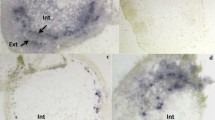Abstract
An Indian isolate of sugarcane mosaic virus was found easily transmitted by mechanical sap inoculation to sugarcane and sorghum plants. Out of different methods tried for mechanical inoculation, Bain’s and Matz’s method gave maximum per cent of infection in inoculated sugarcane and three varieties ofSorghum vulgare (cv. M.P.cherry, CSH-5 and CSH-9). The virus was also found to be transmitted by four aphids, viz.Aphis gossypii, Longiunguis sacchari, Myzus persicae andRophalosiphum maidis. Since the virus could be transmitted most efficiently byR. maidis the detailed study was made with it to establish the virus-vector relationship.R. maidis could acquire virus without any pre-acquisition fasting, but fasting has beneficial effect up to 4h on the acquisition power. In case, fasting is increased beyond 4 h, the efficiency of transmission decreased. The aphid acquire the virus within 30 sec. However, optimum acquisition feeding was obtained in 2 min. but the maximum infection was obtained after 30 min infection feeding of test plants. Even a single viruliferous aphid was enough to initiate the infection. The transmission per cent decreased when the aphids were fasted after acquisition feeding of 2h from 60 to 13 per cent. In serial transfers, the aphids cease to be infective very soon while feeding on the test plants. Thus the virus under study was transmitted apparently by typically non-persistent manner and was stylet borne.
Similar content being viewed by others
References
Ashby, S. F. (1920). The mosaic mottling or yellow stripe disease of cane leaflet Dept.Agr. Jamaica, p. 13.
Bain, D.C. (1944). The use of abrassive for inoculating sugarcane seedlings with the mosaic virus.Phytopathology,34: 844–845.
Baudin, P. (1969). Seed transmission of the sugarcane mosaic virus in maize.Terve Malagcho,8: 197–206.
Bhargava, K. S. (1971). Investigation on virus diseases of sugarcane in relation to sugars Industry. Final Technical Report, P.L.-480 Grant No. FG-In-274, Project No. A7-CR-112, University of Gorakhpur, Gorakhpur, pp.203.
Bhargava, K. S. (1975). Sugarcane mosaic- Retrospect and prospects. Indian Phytopathology28: 1–9.
Bird, J. (1961). Inoculation of sugarcane plant with the mosaic virus using the airbrush.Jour. Agr. Univ. Puerto Rico,45: 1–7.
Bond, W. P. and Pirone, T. P. (1967). Soil transmission of sugarcane mosaic virus in sorghum (Abstr.).Phytopathology,57: 804.
Bond, W. P. and Pirone, T. P. (1970). Evidence for soil transmission of sugarcane mosaic virus.Phytopathology,60: 437–440.
Bradely, R. H. E. (1952). Studies on the aphid transmission of a strain of henbane mosaic virus.Ann. Appl. Biol,39:78–79.
Brandes, E. W. (1920a). Artificial and insect transmission of sugarcane mosaic.J. Agric. Res.,19:131–138.
Bruner, S. C. (1922). Sobre la transmission de la cane de azucar.Rev. Agr. Com. Y. Trab. (Cuba),5:11–22
Dean, J. L. (1960). A spray method for inoculating seedlings with the mosaic virus.Plant Dis. Reptr.,44: 874–876.
Hollings, M. and Brunt, A. A. (1981) Potyvirus group CMI / AAB.Descriptions of Plant Viruses, 245.
Kennedy, J.S., Day, M. F. and Eestay, V. F. (1962). A comparison of aphids as vector of plant viruses.Commonwealth Inst. Entom. London, England
Matz, J. (1933). Artificial transmission of sugarcane mosaic.Jour. Agric. Res.,46:821–840.
Miller, P. W. ( 1952). Relation of a fast period to the aphid transmission of crinkle virus of strawberry.Plant Dis. Reptr,36: 92–93.
Rao, G P. and Ford, R. E. (2001). Vectors of virus and Phytoplasma diseases of sugarcane-An overview, pp 265–314. In: Sugarcane Pathology Vol. II Viral and Phytoplasma Diseases (eds: GP. Rao, R.E. Ford, M. Tosic, D.S. Teakle), Science Publishers Inc., Enfield, NH, USA.
Rao, G P., Singh, M. and Singh, H. N. (1990). Alternative hosts of sugarcane diseases.Sugarcane, Autumn Supplement, pp. 8–26
Rao, GP., Singh, M., Shukla, K. and Singh, H. N. (1992). Epidemiological studies with sugarcane mosaic virus in Eastern Uttar Pradesh, India. In: Virology in tropics (Eds. N. Rishi, K.L. Ahuja and B.P. Singh, Malhotra Publishing Comp., New Delhi (In Press).
Rao, GP., Gaur, R.K. and Singh, Maneesha (2003)Distribution and serological diagnosis of sugarcane mosaic potyvirus in India. Sugar Cane International, Jan/Feb: 6–11.
Rao, GP., Singh, Maneesha and Gaur, R.K. (2002) Occurrence of red leaf mottle disease of sugarcane in India. Sugarcane International, UK, March/April, pp 18–21
Sein, F. Jr., (1932). Artificial transmission and other studies on sugarcane mosaic.Proc. Int. Soc. Sugarcane Techonol. Cong., 4th Bull., P. 84.
Shepherd, R. J. and Holdeman, G. L. (1965). Seed transmission of Jhonsongrass strain of the sugarcane mosaic virus in corn.Plant Dis. Reptr.,49:468–469.
Singh, A.K. (1982). Studies on soime virus disease of cowpea(Vignasinensis(L.) Savi ex Hassk), Doct. Thesis, Univ. Gorakhpur, India.
Singh, R. (1970). Studies on the transmission ofBenicasa mosaic withMyzus persicae Sulz.Phyton,14: 15–21.
Teakle, D. S. and Grylls, N.E. (1973). Four strains of sugarcane mosaic virus infecting cereals and other grasses in Australia.Australian Jour. Agric. Res.,24 (4): 465–477.
Yang, S.L., Pan, Y.S. and Shieh, H.L. (1984). Studies on aphid vectors of SCMV-I. Occurrence of a late aphid in sugarcane field. Report of the Taiwan Sugar Research Institute, No. 105: 33–44.
Watson, M.A. (1936). Factors affecting the amount of infection obtained by aphid transmission of the virus.Hy. III. Phil-Trans. Roy.Soc.B.,225:457–489.
Watson, M.A. and Roberts, F.M. (1939). Comparative study of the transmission of Hyoscymaous virus 3, Potato virus Y and Cucumber virus 1 by theM.circumplexus (Buckton) andM. gei (Koch).Proc. Roy.Soc. London,B127: 543–576.
Author information
Authors and Affiliations
Corresponding author
Rights and permissions
About this article
Cite this article
Singh, M., Singh, A., Upadhyaya, P.P. et al. Transmission studies on an indian isolate of sugarcane mosaic potyvirus. Sugar Tech 7, 32–38 (2005). https://doi.org/10.1007/BF02942526
Published:
Issue Date:
DOI: https://doi.org/10.1007/BF02942526



